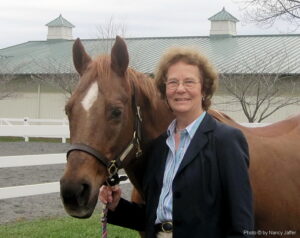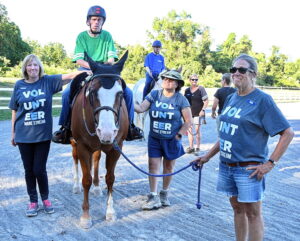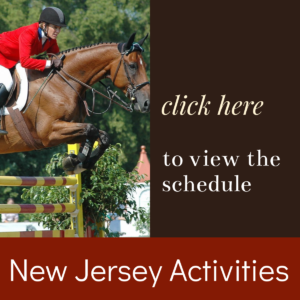It may be hard to believe in this era, but the concept of using horses for organized therapy was still in its infancy when Octavia Brown founded the Somerset Hills Handicapped Riders Club a half-century ago. The once-weekly program began on a rudimentary basis with horses provided by the local Pony Club.
Today, what she started on her Bedminster, N.J., farm has blossomed into an organization with hundreds of dedicated volunteers and deep support from the community.
SHHRC evolved into Mane Stream, which offers clients a long list of vital services, everything from speech pathology to physical and occupational therapy, as well as brightening the lives of those who are living with cancer and debilitating conditions.
As it marks its 50th anniversary, Mane Stream, located on 12 acres in Oldwick. N.J., officially sums up its mission as improving “the quality of life for individuals with physical, developmental, emotional, and medical challenges through a diverse program of equine assisted activities, therapy services, and educational initiatives.”
That’s certainly ambitions and accurate, but what stands out when watching Mane Stream participants is something that can’t be defined with mere words. It’s the joy someone feels from involvement with horses, whether it is simply brushing a pony, speaking for the first time after riding around the ring or break-through moments of leaving the wheelchair behind for freedom on horseback.
“Every new thing that comes along came from that whole beginning of thinking we could think outside the box. That’s exactly why I’ve stayed in it for as long as I have,” said Octavia, who went on from Mane Stream to start the Therapeutic Riding At Centenary University program.
Today, “You can look at youth at risk, you can look at battered women, you can look at all kinds of things that none of us even thought about years ago,” Octavia observed.
You could say she was the Johnny Appleseed of therapeutic riding. At a time when the only course in the country was at Michigan’s Cheff Therapeutic Riding Center, people wouId come to Octavia and tell her, “I want to learn to do what you’re doing.”
So she started training people “and clearly they were gong to go out and do great things.”
Now she is involved on the board of the Horses and Humans Research Foundation.
For a very long time, “No one even thought about having qualitative and quantitative research on aspects of the field,” she recalled.
“The science behind this is starting to really take a firm hold. Maybe hopefully insurance will start to pay for this without quibbling, and people will start to sit up and take notice in areas we don’t even know about yet.”
She will be honored Oct. 1 at the U.S. Equestrian Team Foundation in Gladstone, N.J., where Mane Stream is holding its anniversary gala. (As long as tickets are still available, they can be obtained through equus2022.givesmart.com.)
While Octavia ran her original operation with little help, Mane Stream today employs professionals to handle the ever-increasing aspects of its operation, which is a Premier Accredited Center of PATH (Professional Association of Therapeutic Horsemanship, International).
Overseeing the therapy is Melanie Dominko-Richards, who began her association with Mane Stream at the age of six. Her mother worked down the road at the Oldwick General Store, where Mane Stream personnel would go for lunch. Melanie’s mom sought advice from them on how she should handle her “horse-crazy kid, who needed something to do for the summer.”
Melanie first visited Mane Stream at age six and became a volunteer when she was nine years old, a much younger age than what is allowed today. But it was an important step for her; one, she says, that “put me on the path of where I am today. I just loved it.

Melanie Dominko-Richards, Mane Stream’s director of therapy services with Tink. (Photo © 2022 by Nancy Jaffer)
“I originally came for the horses. That was really the draw. Then I fell in love with the disabilities side of it,” she explained.
“I fostered this love of inclusion and a love of being around all different sorts of people.”
After volunteering through high school and getting a bachelor’s degree in education at Seton Hall University, she got a call from Mane Stream’s director of therapy services, offering her a 10-week gig. It has turned into 11 years. She got a promotion to director of therapy services in 2017. With a master’ in speech language pathology, she is now board president of the American Hippotherapy Association.
Trained in how the biomechanics of the horse implements the biomechanics of the human body, she explained, “Being on a horse kind of organizes the systems of the body.”
For a hyper client who can’t focus, for instance, “the movement of the horse is self-organizing,” she explained. Melanie compared it to a zipper that’s slightly out of line.
“Being on the horse lines up the teeth of the zipper…so I can zip up the zipper. It readies the body for another task, such as speech therapy.
“A lot of clients come for multiple therapies, meet their goals, then move on to occupational therapy or physical therapy. They may also join an adaptive riding program and take a lesson. Our definition of special needs is very broad.”
The idea is to adapt teaching style and equipment to a participant. For instance, to help a client understand how to ride a circle on a horse, different colored cones can be set up to make a circle as the client sets off, then slowly the cones are removed, enabling them to understand how to produce the figure on their own.
Jen Dermody, the head instructor, equine manager and event coordinator, said one of the special things about Mane Stream is “the whole team feel” as volunteers work with professionals in helping clients.
Volunteers are vital to Mane Stream’s success, and each has their own purpose in helping others. Dan O’Donnell, who worked in technology and was a rider for 35 years, used to take his horses on the trails in the Oldwick area and would often pass by Mane Stream.
“When I retired, I decided to come in and see what was going on. It’s kind of nice to do something that’s your hobby anyway,” he noted.
Matt McCann; his wife, Renee, and daughter, Sara, all volunteered. Sara was a jumper rider, so she knew horses, but Matt, a CPA, enjoyed being along for the ride, so to speak, since helping at Mane Stream was an activity he could do with his whole family.
Leroy Hunninghake came in one day just to see what was going on at the facility and encountered someone in the lobby he had worked with in technology for 25 years. The man’s son had autism and was riding, so that inspired Leroy to get involved.
Karen Mikita-Kaufhold, the organization’s president, became involved with Mane Stream when she moved from Bergen County to Hunterdon County and was looking for volunteer work. When she mentioned it to the wife of the CEO at the company where her husband worked, the woman suggested she go to what was then Somerset Hills, because Karen rode horses and wanted to help people.
“I think that would be the perfect fit for you,” the woan said, and she was right.
“Once I began volunteering I loved it, I loved being there,” Karen remembered,
“When I started seeing what they do for the participants, that’s when it got to me; this is more than just the horses. This is helping somebody who is doing therapy on the horse and to see improvements, that’s when it got to me.”
She recounted hearing a little girl who hadn’t talked at all, finally say, “walk on” to the horse.

Occupational therapist Stephanie Egleston (second from right) works with a client with the help of volunteers. (Photo © 2022 by Nancy Jaffer)
“I had tears in my eyes. This is what it’s all about.”
“I am so grateful and cannot thank our supporters enough for their generosity and kindness to help Mane Stream to be able to fulfill our mission and serve our community for 50 years and hope we can continue to for many more years to come,” she said.
Trish Hegeman, Mane Stream’s executive director for six years, reflected on 50 years of progress. She notes, “We’ve come a long way in terms of keeping people safe; we know a lot more about the right way to do things, we’ve learned a lot more abut how to engage with certain participants. We’ve definitely moved forward and are definitely interested in staying as a leader in the industry.”
The board adopted a strategic plan earlier this year, but one of the key questions that remains for discussion is “What’s next? What do we want to do?”
Getting more space is one question that will be dealt with in discussions next year, since at the current location, things are “built out as much as they can be.”
While the adaptive riding program moves in the winter to a board member’s farm where there’s a big indoor ring, the organization would like to have its own large indoor for lessons. The current indoor, used for therapy, is too small for that.
A client may have a diagnosis of ADHD, anxiety or some other condition. The horses are trained to carry riders who are not balanced or do unexpected things; perhaps they have muscle spasms, for example.
There is a big demand for adaptive riding, focusing on “anyone who’s not going to be successful in a typical riding environment.”
“We want people to be successful and independent, and those are not two things that happen all the time in other environments to people who come here,” said Trish.
Their Mane Stream experience “gives them something be successful at. Our people who might have other challenges in their life, and life is not so easy for them, are able to get on these big animals and tell them what to do. There’s something super-empowering about that.”






